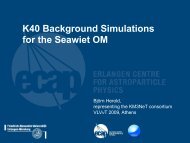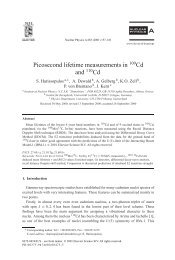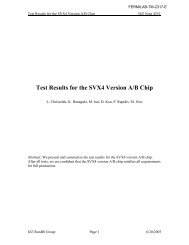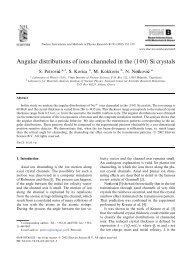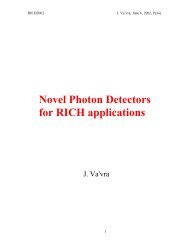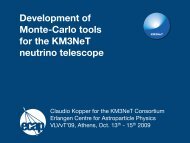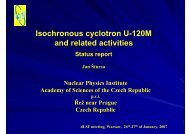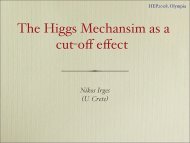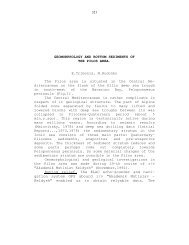"Operation and performance of the NESTOR test detector" Nucl.Instr ...
"Operation and performance of the NESTOR test detector" Nucl.Instr ...
"Operation and performance of the NESTOR test detector" Nucl.Instr ...
Create successful ePaper yourself
Turn your PDF publications into a flip-book with our unique Google optimized e-Paper software.
ARTICLE IN PRESS<br />
G. Aggouras et al. / <strong>Nucl</strong>ear <strong>Instr</strong>uments <strong>and</strong> Methods in Physics Research A 552 (2005) 420–439 431<br />
remain stable, corresponding to <strong>the</strong> emission <strong>of</strong> a<br />
very few photoelectrons.<br />
In a typical example shown in Fig. 10a, <strong>the</strong> pulse<br />
height distribution has a shape corresponding to a<br />
few (average 1.3) photoelectrons. This distribution<br />
can be described very well as <strong>the</strong> overlay <strong>of</strong> <strong>the</strong><br />
one-photoelectron (see insert plot) <strong>and</strong> two-photoelectron<br />
pulse height distributions, measured in <strong>the</strong><br />
laboratory during <strong>the</strong> detector calibration. The<br />
average number 1.3 <strong>of</strong> photoelectrons is not <strong>the</strong><br />
mean <strong>of</strong> a Poissonian distribution but <strong>the</strong> mean <strong>of</strong><br />
<strong>the</strong> distribution in <strong>the</strong> main plot (after <strong>the</strong><br />
subtraction <strong>of</strong> <strong>the</strong> exponential contribution for<br />
<strong>the</strong> dark current, line a) normalized to <strong>the</strong> mean <strong>of</strong><br />
<strong>the</strong> calibration pulse height distribution for single<br />
photoelectron (insert plot). The contribution <strong>of</strong><br />
<strong>the</strong> two-photoelectron component is surprisingly<br />
high [1]. It cannot be attributed to late photomultiplier<br />
pulses, because <strong>the</strong>y were measured in<br />
<strong>the</strong> laboratory <strong>and</strong> are less than 1%, or to<br />
radioactive contamination <strong>of</strong> <strong>the</strong> photomultiplier<br />
glass <strong>and</strong>/or <strong>the</strong> glass sphere protective housing,<br />
because <strong>the</strong> laboratory measurements (insert in<br />
Fig. 10a) were done with <strong>the</strong> same Optical<br />
Module.<br />
The K 40 background has been used as a stable<br />
‘st<strong>and</strong>ard c<strong>and</strong>le’ in order to monitor <strong>the</strong> gain<br />
stability <strong>of</strong> <strong>the</strong> detector. The pmt pulse height<br />
distributions from each data file were compared to<br />
a st<strong>and</strong>ard shape defined at <strong>the</strong> beginning <strong>of</strong> <strong>the</strong><br />
run <strong>and</strong> found to be extremely stable for all <strong>of</strong> <strong>the</strong><br />
pmts during <strong>the</strong> whole running period.<br />
However, <strong>the</strong>re were periods <strong>of</strong> time when <strong>the</strong><br />
instantaneous counting rates <strong>of</strong> a group<strong>of</strong> pmts<br />
<strong>and</strong> <strong>the</strong> collection trigger rate show a large<br />
increase; Fig. 10b gives an example <strong>of</strong> such<br />
behaviour. The downlooking group<strong>of</strong> pmts<br />
exhibits a synchronous increase <strong>of</strong> counting rates<br />
whilst <strong>the</strong> o<strong>the</strong>rs remain relatively quiet, indicating<br />
that <strong>the</strong>re is probably a localized light source<br />
below <strong>the</strong> detector. These phenomena last typically<br />
from 1 to 10 s <strong>and</strong> represent a total 1.1% <strong>of</strong> <strong>the</strong><br />
active experimental time. The effect is consistent<br />
with bioluminescent activity from marine organisms<br />
in <strong>the</strong> detector vicinity.<br />
The pulse height distribution <strong>of</strong> <strong>the</strong> pmts during<br />
a period <strong>of</strong> bioluminescence is very similar to <strong>the</strong><br />
distribution due to <strong>the</strong> K 40 decay. To demonstrate<br />
this, Fig. 11 compares <strong>the</strong> distribution <strong>of</strong> <strong>the</strong> total<br />
number <strong>of</strong> accumulated photoelectrons inside <strong>the</strong><br />
trigger window with a 4-fold or higher level<br />
coincidence trigger for events collected during<br />
periods with <strong>and</strong> without bioluminescence activity.<br />
Bioluminescence can be easily identified because<br />
<strong>of</strong> its characteristic time duration <strong>and</strong> <strong>the</strong>refore<br />
does not cause any background problem. In <strong>the</strong><br />
analysis that follows, all events collected during<br />
periods <strong>of</strong> bioluminescence activity have been<br />
excluded. This represents a reduction <strong>of</strong> only<br />
1.1% in <strong>the</strong> size <strong>of</strong> <strong>the</strong> data sample. 9<br />
The average experimental trigger rate, corresponding<br />
to <strong>the</strong> coincidence <strong>of</strong> four or more pmt<br />
pulses above 30 mV amplitude, was 3.76 Hz<br />
compared to an estimated rate <strong>of</strong> 3.79 Hz derived<br />
from <strong>the</strong> Monte Carlo simulations (see Section 5).<br />
According to <strong>the</strong> Monte Carlo estimation, only<br />
a small fraction (5.5%, 0.21 Hz) <strong>of</strong> this trigger rate<br />
corresponds to atmospheric muons passing close<br />
to <strong>the</strong> detector. When <strong>the</strong> pmt thresholds were set<br />
to 120 mV, <strong>the</strong> measured trigger rate was 0.29 Hz,<br />
in agreement with <strong>the</strong> equivalent Monte Carlo<br />
estimate <strong>of</strong> 0.30 Hz.<br />
Fur<strong>the</strong>rmore, <strong>the</strong> measured coincidence rates,<br />
shown in Fig. 12, are in very good agreement with<br />
<strong>the</strong> Monte Carlo estimations for several levels <strong>of</strong><br />
coincidence at different pmt thresholds. In <strong>the</strong><br />
same plots, we present <strong>the</strong> Monte Carlo estimated<br />
contribution <strong>of</strong> <strong>the</strong> atmospheric muon flux to <strong>the</strong><br />
triggers, showing that higher-level coincidences<br />
exclude <strong>the</strong> combinatorial background. A better<br />
rejection <strong>of</strong> <strong>the</strong> combinatorial background is<br />
achieved at higher pmt threshold values.<br />
Several studies have been made to ensure that all<br />
<strong>the</strong> collected light on <strong>the</strong> pmts can be attributed to<br />
<strong>the</strong> known sources. Since higher coincidence levels<br />
reject better <strong>the</strong> combinatorial background, <strong>the</strong><br />
dependence <strong>of</strong> <strong>the</strong> total number <strong>of</strong> collected<br />
photons per event on <strong>the</strong> coincidence level has<br />
been studied. The total number <strong>of</strong> accumulated<br />
photoelectrons inside <strong>the</strong> coincidence window has<br />
been used as a measure <strong>of</strong> <strong>the</strong> total number <strong>of</strong><br />
9 High levels <strong>of</strong> bioluminescence [28] can cause severe deadtime<br />
in data taking. Note that in o<strong>the</strong>r Mediterranean sites,<br />
periods with more than 30% <strong>of</strong> bioluminescence activity has<br />
been observed [29].



